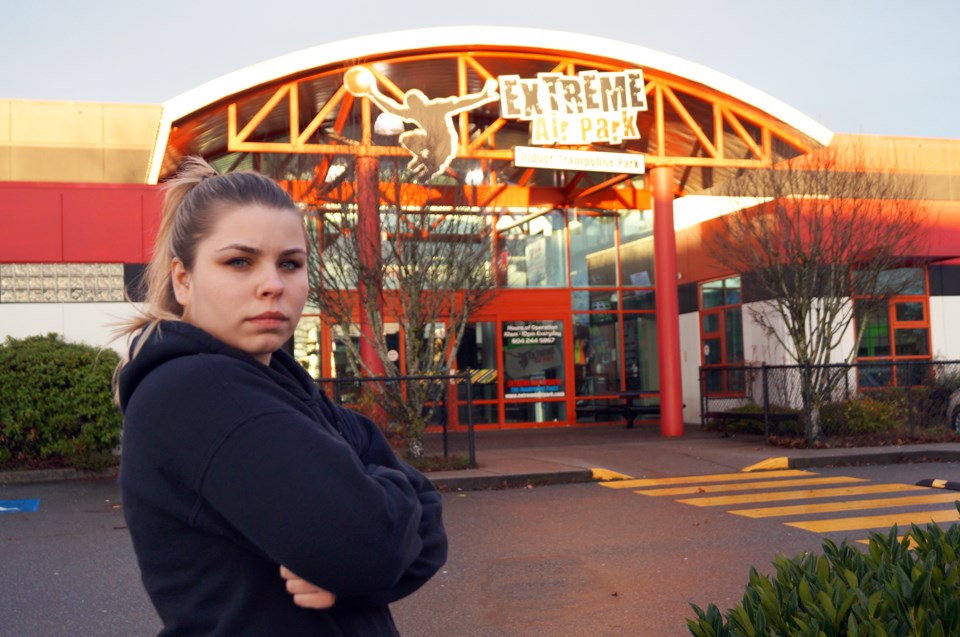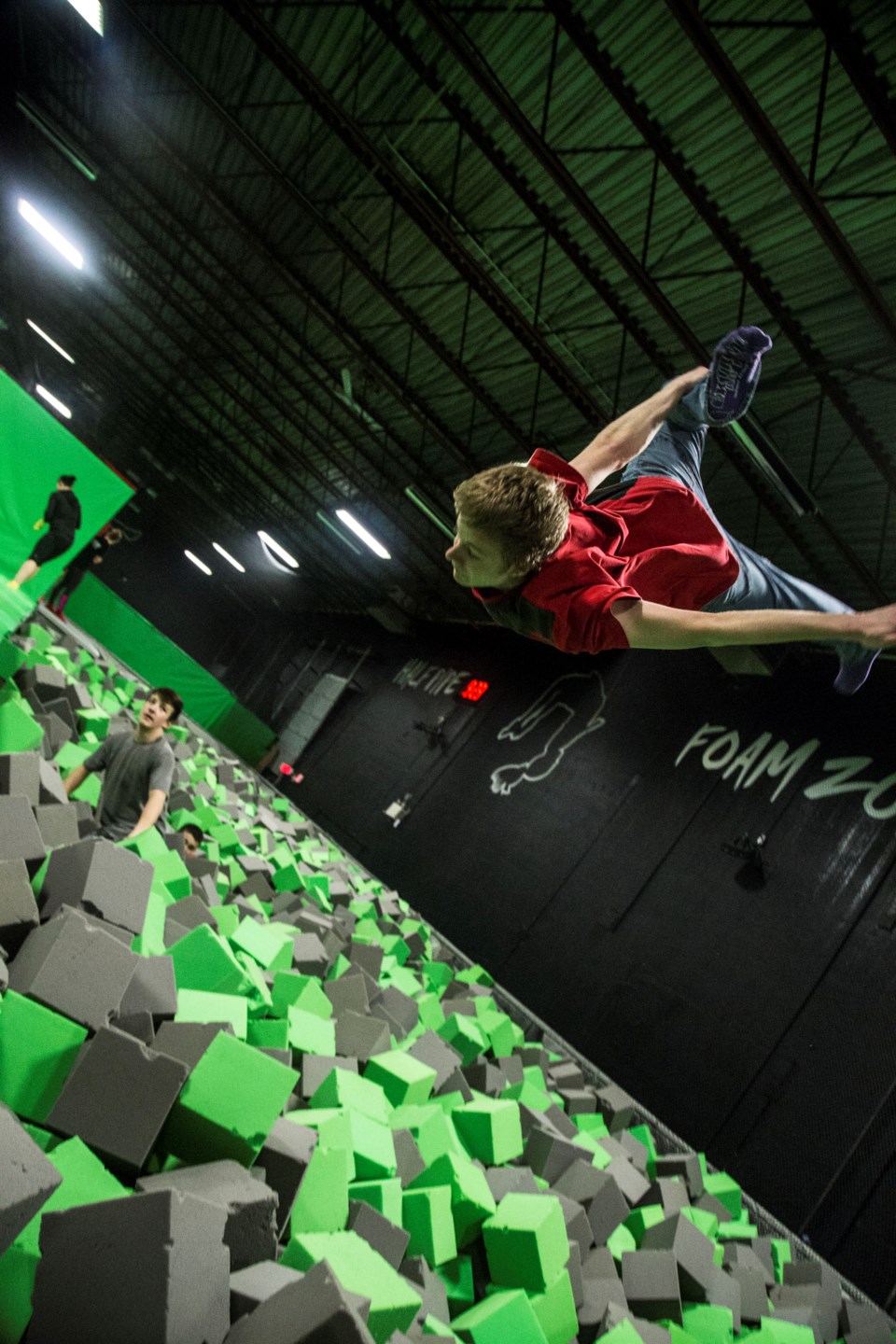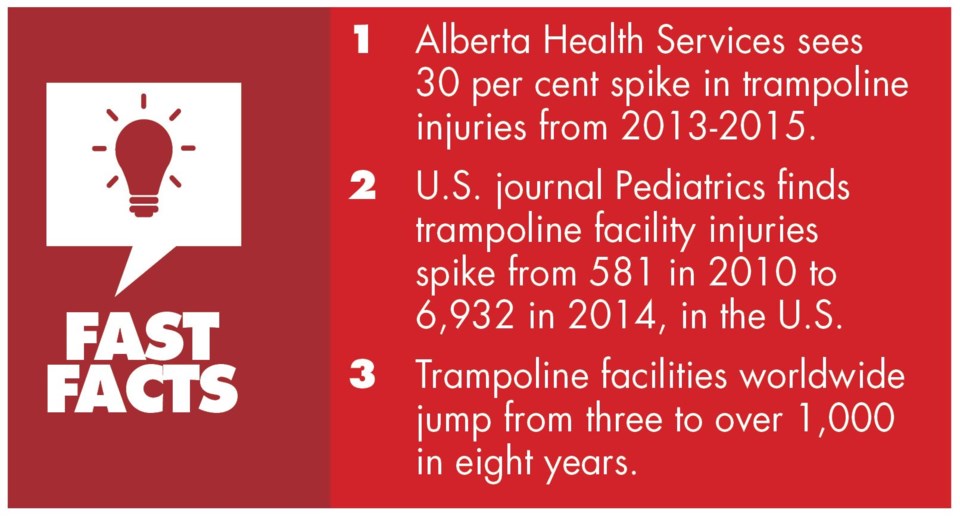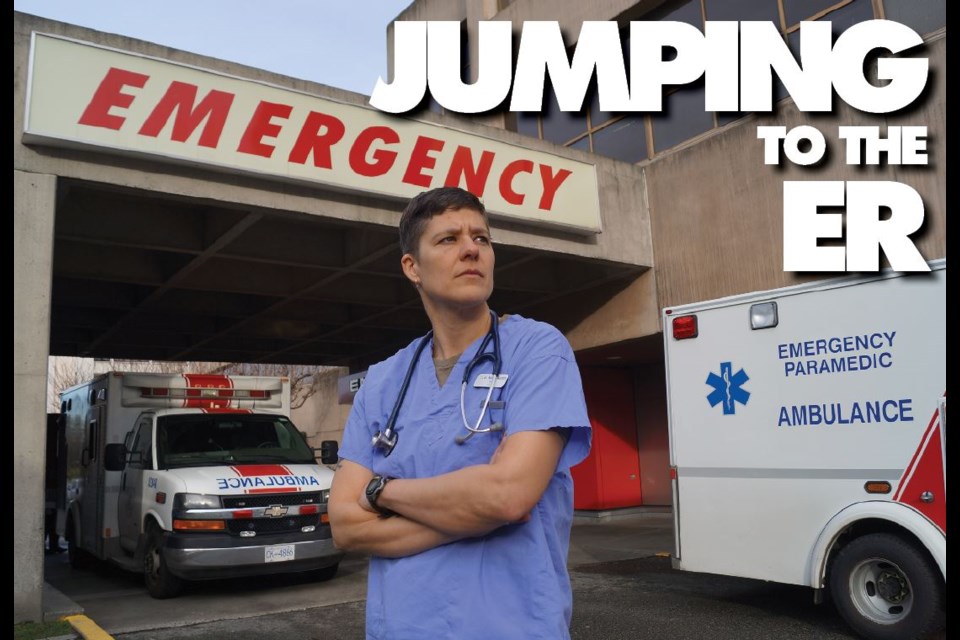Over the past five years, Dr. Nancy Austin, department head for emergency medicine at Richmond Hospital, says she’s seen a “dramatic” increase in trampoline-related injuries.
Such injuries have received little public attention in Canada until a recently-publicized civil lawsuit in Alberta and the death late last month of a 46-year-old father at Richmond’s Extreme Air Park, a trampoline facility.
“There’s an inherent risk to trampolining and, in general, the public is unaware of this,” said Austin.
The matter has garnered more attention in the United States, where the trampoline facility industry has begun to self-regulate and receive some legislated, regulatory support in some states, following a reported rise in trampoline facility injuries that parallel an increase in facilities.
But in Canada, as more trampoline facilities open to the public, enforceable safety regulations remain non-existent. Furthermore, B.C. health officials have yet to compile comprehensive data to assess the true scope of the problem — although in Richmond, and across B.C., this work has begun.
“Some of the injuries are minor. Some of them are more serious, including neck injuries, dislocation of shoulders and ankles. We’ve definitely seen many compound fractures from trampoline facilities,” said Austin, noting the most critical injuries — such as the one suffered by Victoria contractor Jay Greenwood at Extreme Air Park on Jan. 20 — are tended to in Vancouver.
Greenwood’s tragic death, resulting from a broken neck and cardiac arrest, has prompted serious questions from past employees and customers of Extreme Air Park, as well as calls for government and/or industry regulations.
Since 2014, the facility’s owner Extreme Air Park Inc. and related Langley operation Extreme Air Park 2 Ltd. have been subject to three civil suits connected to personal injuries.
According to several eyewitness accounts of Greenwood’s death, now under a police investigation, no park employees were able to assess his injuries as his body lay in a foam pit.
Customer Charlie Bouzakis told the Richmond News it was he who jumped in first to check on Greenwood’s condition, following what police described as an acrobatic stunt in the foam pit gone awry.
“Was there proper protocol in place prior and enough qualified staff on duty to execute the action that needed to be done in this case?” asked Bouzakis.

While Extreme Air Park has declined to comment to the News, the incident prompted concerns from a number of former employees and customers, including Michelle Cooper, who worked at the park when it opened in 2013.
“When we had people come in, we had them sign the waivers, took them to a gate and put socks on. I’d give them a big spiel. There were rules we had to go through. There were 20-25. I thought it covered everything at the time. But that we (staff) didn’t have first aid; that really bothered me,” said Cooper, 25.
She said she offered to get first aid training after being hired but management didn’t follow up.
“I think everybody should at least have [standard] first-aid and someone should be there with [advanced] first aid, so they can stabilize someone’s neck if they fall,” said Cooper, who described the staff as young and unaware of the risks to customers.
Similar thoughts resonated with Mike Smiley after reading about Greenwood’s death.
Smiley, a paramedic, told the News he walked into the facility in late 2016 to find a young girl with an un-stabilized arm fracture sitting on a bench, by herself, waiting for an ambulance to arrive.
“I was angry,” said Smiley. “When I was there they didn’t have a roll of medical tape on hand.
“I said, ‘where is the first aid kit? You guys aren’t doing anything. Let me treat her,’” said Smiley, who also thinks advanced, emergency first-aid training is needed at such facilities.
According to the B.C. Ministry of Health and B.C. Ministry of Public Safety, there are no regulations with respect to trampoline facilities at this time.
However, other leisure activities that carry risks to safety do have regulations. For instance, the B.C. Guidelines for Pool Operations dictates that public pools cannot operate without at least one lifeguard on duty. These lifeguards are required to hold first-aid certification to handle pool-specific injuries.
Vancouver Coastal Health Medical Health Officer Dr. Emily Newhouse said the first step to regulations is understanding the problem. In B.C. there is no comprehensive trampoline-injury data to report, said Newhouse — although VCH is working on this.
“What we would like to learn more about is the full scope of the injuries. After we saw national data, not all of it is recent. But we heard from our ERs that we’ve been seeing an increase in injuries from these facilities. We also heard from colleagues across the province,” said Newhouse.
As reported in the U.S. journal Pediatrics: “Estimated U.S. emergency department visits for TPI (trampoline park injuries) increased significantly, from 581 in 2010 to 6,932 in 2014, whereas HTI (home trampoline injuries) did not increase.”
Alberta Health Services found a 30 per cent increase in trampoline injuries between 2013 and 2015, with local health professionals pointing to an increase in trampoline facilities as the cause. Last month, Alberta MLA Wayne Drysdale asked the government if it plans to address injuries and regulations at trampoline facilities following the paralysis of Landon Smith, 19, who is now suing an Edmonton-area trampoline facility for $17 milllion.

In 2013, the Canadian Pediatric Society stated, “There has been an alarming increase in the rate of hospital admissions in Canada resulting from trampoline-related injuries,” largely from backyard trampolines.
“For myself, the risks of going to a trampoline facility are high, so I would not recommend that children use those facilities. Any time you’re doing an activity that carries risk . . . there should be skilled first-aid practitioners on site,” said Newhouse.
Last year, VCH embarked on a public safety campaign to raise awareness of the injury risks.
Evidence-based safety tips included: only one person at a time; closely supervised children; no jumping on or off a trampoline; safety nets; limiting flips and somersaults.
But the “Air on the side of caution” campaign was only directed toward backyard trampolines.
Facilities such as Extreme Air Park, with a lengthy board of rules and mandatory “safety socks” may give a false sense of security, said Cooper, considering there’s no apparent first-aid training and limited supervision at times.
“You have trampoline basketball; people are flying all over the place,” she added.
The Canadian Pediatric Society and Health Canada oppose the use of trampolines by anyone under age seven.
“Trampolines are very risky for children and should be avoided for anyone less than seven years of age,” asserted Austin.
Extreme Air Park only suggests that “jumpers under 7 must not be left unattended on courts.”
Just last month, the company settled a claim for $3,000 and agreed to “conduct a review of their practices and procedures relating to children under the age of five.”
There are attempts in the U.S. to address such gaps in messaging between health officials and trampoline park operators.

The industry-led, U.S-based International Association of Trampoline Parks (IATP) states it “believes that legislative initiatives and lobbying efforts are necessary to ensure the long term success of the indoor trampoline park industry.”
“Our efforts are directed at advocating for all parks to be safe by promoting industry supported responsible legislation that creates standards and regulations that protect both park owners and patrons alike,” claims IATP.
However, IATP does not claim to be a regulatory body that creates safety standards in and of itself.
For instance, IATP makes no mention of first aid requirements for its members.
Extreme Air Park is not a member of IATP, although another Richmond facility — Apex Adventure Plex Richmond — is.
Apex nevertheless offers “toddler time,” with only a recommended minimum age of 3-4 years-old.
While IATP claims to focus on only advocating for developing regulations in local jurisdictions, it does advocate openly for equipment standards based on ASTM International.
It recommends certain standards for foam pits, such as jumping height and “how to construct a pit to avoid contact with the floor.”
IATP notes industry growth is on the rise, from three parks in 2009 to over 1,000 parks worldwide by 2017.
In the last two weeks, four B.C. trampoline parks have joined IATP, which has offered to work with B.C. health officials in drafting regulations.
According to Gymnastics Canada, nationally-trained gymnasts are concerned about the unregulated industry.
“The safety of participants in all gymnastics-related facilities is of the utmost concern for Gymnastics BC and Gymnastics Canada,” said Gymnastics BC CEO Brian Forrester.
However, his association’s gyms are not affiliated with trampoline facilities and Gymnastics BC gyms follow rigorous, national, industry-led safety standards, including spinal cord and CPR first-aid certified supervision.
“We encourage anyone who wishes to participate in gymnastics-related activities to seek out Gymnastics BC full member clubs,” said Forrester.



